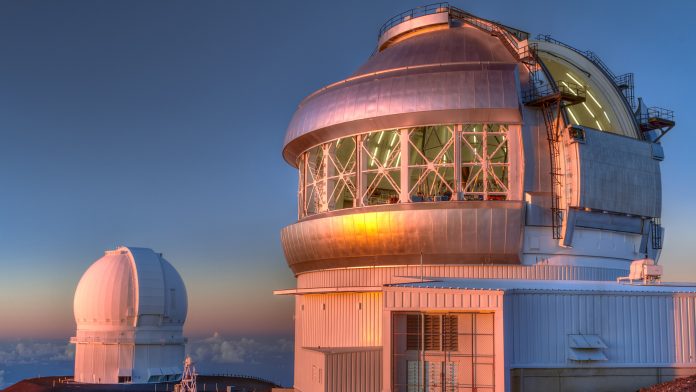An ultra-faint dwarf galaxy has been discovered on the outer fringes of the Andromeda galaxy by an amateur astronomer.
An unusually ultra-faint dwarf galaxy has been discovered on the outer fringes of the Andromeda galaxy due to an amateur astronomer examining archival data processed by NSF’s NOIRLab’s Community Science and Data Centre. After an analysis by professional astronomers using the International Gemini Observatory, a programme of NSF’s NOIRLab, revealed that the dwarf galaxy -Pegasus V – contains few heavier elements and is likely to be a fossil of the first galaxies.
Pegasus V: Analysing an ultra-faint dwarf galaxy
The galaxy, called Pegasus V, was first detected as part of a systematic search for Andromeda dwarfs coordinated by David Martinez-Delgado from the Instituto de Astrofísica de Andalucía, Spain, when amateur astronomer, Giuseppe Donatiello, discovered an interesting ‘smudge’ in data in a DESI Legacy Imaging Surveys image.
The image was taken with the U.S. Department of Energy’s Dark Energy Camera on the Víctor M. Blanco 4-metre Telescope at Cerro Tololo Inter-American Observatory (CTIO). The data was then processed through the Community Pipeline which is operated by NOIRLab’s Community Science and Data Center (CSDC).
Closer observations – performed by astronomers using the larger, 8.1-metre Gemini North telescope with the GMOS instrument – revealed faint stars in Pegasus V, confirming that it is an ultra-faint dwarf galaxy on the outskirts of the Andromeda galaxy. Gemini North, located on Maunakea in Hawai’i is half of the International Gemini Observatory.
Gemini observatory observations
The observations utilising Gemini North revealed that the galaxy appears to be extremely deficient in heavier elements compared to similar dwarf galaxies, meaning that it is very old and likely to be a fossil of the first galaxies in the Universe.
“We have found an extremely faint galaxy whose stars formed very early in the history of the Universe,” commented Michelle Collins, an Astronomer at the University of Surrey and lead author of the paper. “This discovery marks the first time a galaxy this faint has been found around the Andromeda galaxy using an astronomical survey that wasn’t specifically designed for the task.”
What galactic relics can tell us about the galaxy
The importance of discovering an ultra-faint fossil galaxy is that galactic relics contain clues about the formation of the earliest stars. While astronomers expect the Universe to be teeming with faint galaxies, like Pegasus V, they have not yet discovered nearly as many as their theories predict. If there are truly fewer faint galaxies than predicted this would imply a serious problem with astronomers’ understanding of cosmology and dark matter.
Discovering examples of these faint galaxies is therefore an important endeavour, but also a difficult one. Part of the challenge is that these faint galaxies are extremely tricky to spot, appearing as just a few sparse stars hidden in vast images of the sky.
“The trouble with these extremely faint galaxies is that they have very few of the bright stars which we typically use to identify them and measure their distances,” explained Emily Charles, a PhD student at the University of Surrey. “Gemini’s 8.1-metre mirror allowed us to find faint, old stars which enabled us both to measure the distance to Pegasus V and to determine that its stellar population is extremely old.”
When compared with the other faint galaxies around Andromeda, Pegasus V seems uniquely old and metal-poor, indicating that its star formation ceased a long time ago.
“We hope that further study of Pegasus V’s chemical properties will provide clues into the earliest periods of star formation in the Universe,” explained Collins. “This little fossil galaxy from the early Universe may help us understand how galaxies form, and whether our understanding of dark matter is correct.”
The capabilities of the Gemini North observatory
“The public-access Gemini North telescope provides an array of capabilities for community astronomers,” said Martin Still, Gemini Program Officer at the National Science Foundation. “In this case, Gemini supported this international team to confirm the presence of the dwarf galaxy, associate it physically with the Andromeda galaxy, and determine the metal-deficient nature of its evolved stellar population.”
Upcoming astronomical facilities are set to shed more light on faint galaxies. Pegasus V dates back to the reionisation stage of the Universe’s evolution, and other objects dating back to this time will soon be observed with NASA’s James Webb Space Telescope. Astronomers also hope to discover other faint galaxies in the future using Vera C. Rubin Observatory, a programme of NSF’s NOIRLab. Rubin Observatory will conduct an unprecedented, decade-long survey of the optical sky called the Legacy Survey of Space and Time (LSST).









